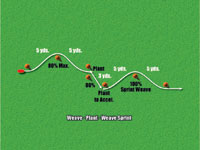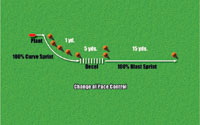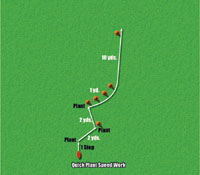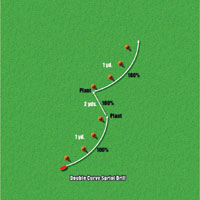AMERICAN FOOTBALL MONTHLY THE #1 RESOURCE FOR FOOTBALL COACHES
Article CategoriesAFM Magazine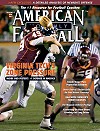
|
Speed Report: Wide ReceiversQuickness, change of pace and acceleration skills - Part IIby: Dale Baskett Football Speed Specialist © More from this issue Last month we covered the idea that just looking at linear (straight) speed is not good enough when preparing a receiver for the type of speed endeavors required. The key to being a truly effective receiver requires a multitude of speed skills. Quickness, the ability to move to a new direction (separation from an angle of velocity travel to another angle of velocity) requires either natural gifts or proper mechanical and physiological training. As you can now appreciate – by reading the articles I provide month-to-month – I am a believer in movement skill development. Keep in mind that as I’ve clearly indicated over time that football requires multi-move skill development which I’ve indicated rhetorically over the last several articles. Athletes’ movement procedures stem from innate responses rather than a cognizant plan of movement organization. Football speed is certainly not indifferent to this fact. Therefore, we should teach visualization of every task at hand. As your wide receivers cognizantly perceive the task of executing by design running precision routes, they should be coached to execute drills by looking at the drill, organizing a plan and then executing what was visualized. During the course of a receiver’s prescribed movements, he must become acclimated to what I refer to as conscious override. This merely refers to the athlete being able to see the task at hand prior to engaging himself with the actual movement procedure. This is the visual and mental perception capability needed to be a successful receiver and to be able to execute a pattern skillfully. Most, if not all positions on the field of play, technically require the same aforementioned aspects of mental and visual perception tasks. Being an ex-receiver coach, I am biased to this conclusion of thought simply because my best executors of routes were visual perception monsters. If you can see visually self-performing your assignment flawlessly before you take a step, you will play faster, simply because you move without reservation. This is psychomotor functioning, (muscular activity associated with mental processing). This is trained by teaching your athletes to have a visual focus prior to all movement tasks at hand. Every time you run a route or perform a receiver speed drill, you must see the task executed with relentless perfection. The most impressive person I’ve had the good fortune to witness execute this physical and visual skill for precise psychomotor function is the great Hall of Fame receiver, Steve Largent of the Seattle Seahawks. As mentioned in the last article on wide receivers, Steve Largent was a unique individual with great gifts. However, the ability to be a talented, quick, fast and controlled receiver can be trained to an inordinate level of proficiency. Steve was certainly one who overcame the physical limitations of most superstars by applying psychomotor training to his repertoire of development. As an interesting side note on Largent, he was taken in the latter rounds of the draft and shortly thereafter put on waivers by the team that took him. No one claimed him off of waivers but he was picked up by the Seattle Seahawks at the last minute. Fortunately, his ex-coach at Tulsa University was new at the Seahawks as a receiver coach. Former NFL quarterback Jerry Rhome coached Steve when he was at Tulsa. He convinced the Seahawks personnel to take a chance on him when no one else would claim him off of waivers. He was that close to never seeing a football field again and went on to play 14 years, breaking nearly every wide receiver record in the NFL. He is currently in the Hall of Fame and still holds various statistical records. The following drills will help you with developing your wide receivers’ ability to have better quickness, change of pace and acceleration skills. These facets can be developed with utilizing good movement skill applications. Here are some drills I offer you for quickness, change of pace and acceleration speed for your wide receivers. Diagram # 1 – Speed Weave Progression This application requires shoulder steering left to right while keeping the arm cycle continuously active. Elbows stay close into the sides during arm phase activity. The first three-cones weave at 60%, the next three cones rotate cycle speed to 80% and, last, the weave zone sprint at 100%. The eyes stay level and arm activity activates faster each three-cone phase (change of pace control drill).
Diagram # 2 – Weave Plant and Weave Sprint Drill Sprint with shoulder steering left, right at 80% to an extension plant at a 45 degree angle, then plant back to another up field 100% sprint weave. The key focus is the shoulder; it must be kept continuously active on all plants and angle changes.
Diagram # 3 – Change of Pace Control Drill Release step pattern is right-left at 100% to a plant followed by a curve sprint at 100% velocity. Decel the arm rotation in the five-yard decel zone. Keep the hips up on the decel and the leg, torso and head in alignment through the entire zone. Burst to a full 100% sprint for the final zone. This drill offers quick plant skill in short space and work on curve speed skills as well as change of pace control and linear (straight) sprint speed.
Diagram # 4 – Quick Plant Speed Drill Come out of a receiver stance with one step to plant, two steps to plant, two steps again to plant, and finishing with a curve sprint to up field acceleration. The key focus is to keep arm rotation non-stop on all plants. Keep leg, torso, and head in alignment as momentum is displaced on each direction change. As the athlete sprints the curve, he should lean slightly with the shoulder while keeping the elbows in close as arm rotation is applied aggressively.
Diagram # 5 – Double Curve Sprint Drill This pure curve sprint is at 100% to angle plant. The objective is to keep the foot strike to the center of the mass on the plant angle change. Arms are non-stop, elbows in and eyes level. Extension plants are the key to separation speed needed during the two plants.
|
|
| HOME |
MAGAZINE |
SUBSCRIBE | ONLINE COLUMNISTS | COACHING VIDEOS |
Copyright 2024, AmericanFootballMonthly.com
All Rights Reserved



